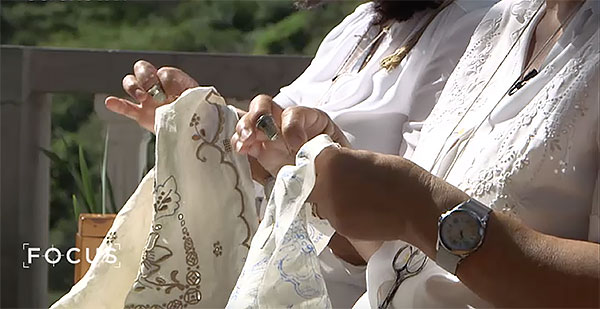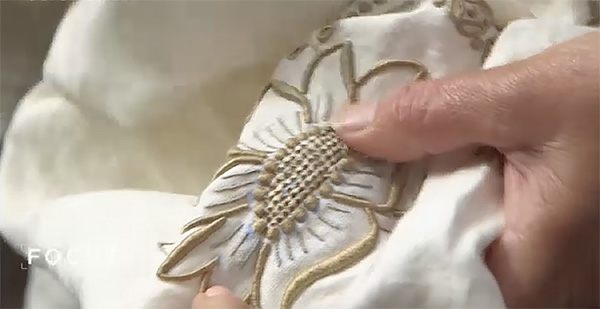I love it when hand embroidery that’s been carried on for generations and generations hits the news. I think it’s a good sign that we still appreciate – and have a need for – beautiful handmade goods!
Recently, Euronews published a small blurb and video on hand embroidery from Madeira, off the northwest coast of Portugal.
The video is definitely worth watching! It demonstrates the value of handing down needlework skills through generations.

There are many beautiful aspects to Madeira embroidery, but my favorite, I think, is their use of satin stitch.
Madeira embroidery is done “in hand,” without the aid of a hoop, and the satin stitches are worked over the curve of the finger. The embroiderers wear a thimble or similar device on the finger underneath the fabric where they’re working the satin stitch, to protect the finger.
In the video, which you can watch here, you’ll see the stitchers skillfully managing beautiful satin stitched and buttonhole stitched areas in this manner.
Madeira embroidery involves several techniques – satin stitching, cutwork, areas filled with texture, pulled thread fillings, sometimes appliqué, and so forth. It is characteristically a combination of whitework embroidery styles, though it is often worked in monochrome or slightly varied, light color schemes.

More Info on Madeira Embroidery, Online
If you’d like to read more about Madeira embroidery, Bordado Madeira has some good history, along with information on the stitches and techniques used.
Two Good Reference Books
There are two books I’ve come across on Madeira embroidery that are good: The Embroidery of Madeira by Carolyn Walker and The Art of Madeira Embroidery by Lilly McAnge.
Both are available used these days – I’ve added the used listings to my Amazon Recommendations page here, if you want to snatch a copy of either while they’re still available. If you have an interest in this type of embroidery, they’re both great books to have for reference.
I hope you enjoy the video and that your week is off to a jolly good start!
This article includes an affiliate link to my Amazon recommendation page, which means that any purchases made through that link will result in a small kickback to Needle ‘n Thread without any extra cost to you.







I have a few pieces very similar to that my great grandmothers made. They were from near Palermo.
Thank you for sharing.
I have been fortunate enough to visit Funchal and take classes at the Imperial Bordados, which is no longer in business. The pictures and information in your article brought a smile to my face as I remembered stitching diligently throughout the week on my hand towel. The embroideresses are wonderfully talented. It was amazing to watch them. One of my favorite pictures that I took was of a little girl, about 5 or 6 years old, sitting at her mother’s knee, stitching away.
Thanks for this wonderful article.
Years ago I lived in Brussels and had a Portuguese housekeeper from Madeira. Her whole family did needlework. For Christmas one year she gave me a round table cloth and 8 napkins . All were Madeira style embroidered around the
Edge with the flowers I raised on my 25’ x 4’ deck – roses, tulips, pansies, petunias, daffodils, vines. They are gorgeous and I cherish the gift.
Many thanks, Mary, for the link to the video! I’m interested in all sources addressing embroidery, especially traditional embroidery. Since I don’t watch TV, I usually don’t know what’s going on in the TV world and rarely come upon a relevant programme. That’s why I appreciate every reference I can get.
This video is very interesting. I would love to sit all day stitching next to these ladies. However, I doubt if I could meet their high standards. Their work is simply stunning – so delicate and subtle!
Angela from the Ore Mountains
Wonderful video and craftsmanship. I kept waiting to see what they had on the finger that they embroider on top of!
Just beautiful! I wish I could adorn every table and furniture top in my house with these pieces. Thanks for the video Mary!
Thank you for this article, I was born in Madeira and although my grandmother was a prolific embroiderer, she sadly did not wish to pass on her expertise, for her it was a job (a burden) not an enjoyment. She would be very disappointed in her granddaughter (me), who loves nothing better than to embroider, it relaxes me and I love it. Unfortunately I cant do the same work as my grandmother, but one day I hope to learn.
That looks fun! I’ve seen it in some of the very old needlework books and was always tempted to try it! The ladies are so fortunate to be able to do what they love.
Dear Mary,
it is with interest that I follow your blog. Yesterdays entry regrding Madira mbroidery brought back good memmories. It must have been round 1991 that I spend my summer holiday on the Island. The vist to the large embroidery firm in Funchal, the capital of Madeira and the the neighbouring Island of Poto Santo, is omjething which I will not forget. The Island has a very mild climate. This is mainly due to the fct that the Maroccan coast is less than 500 miles behind the horizon.
Yours,
Johan Terlouw
SOUTHwest, not northwest 🙂
Dear Mary
Such an interesting video on this unique Madeira embroidery. These ladies are so accomplished and they make it look so easy and interesting and needlework without a hoop. Thanks for sharing with us Madeira embroidery their work is amazing, and for the video links provided.
Regards Anita Simmance
What is the guild seal called. I think gramile but I’m not spelling it correctly. Thank you.